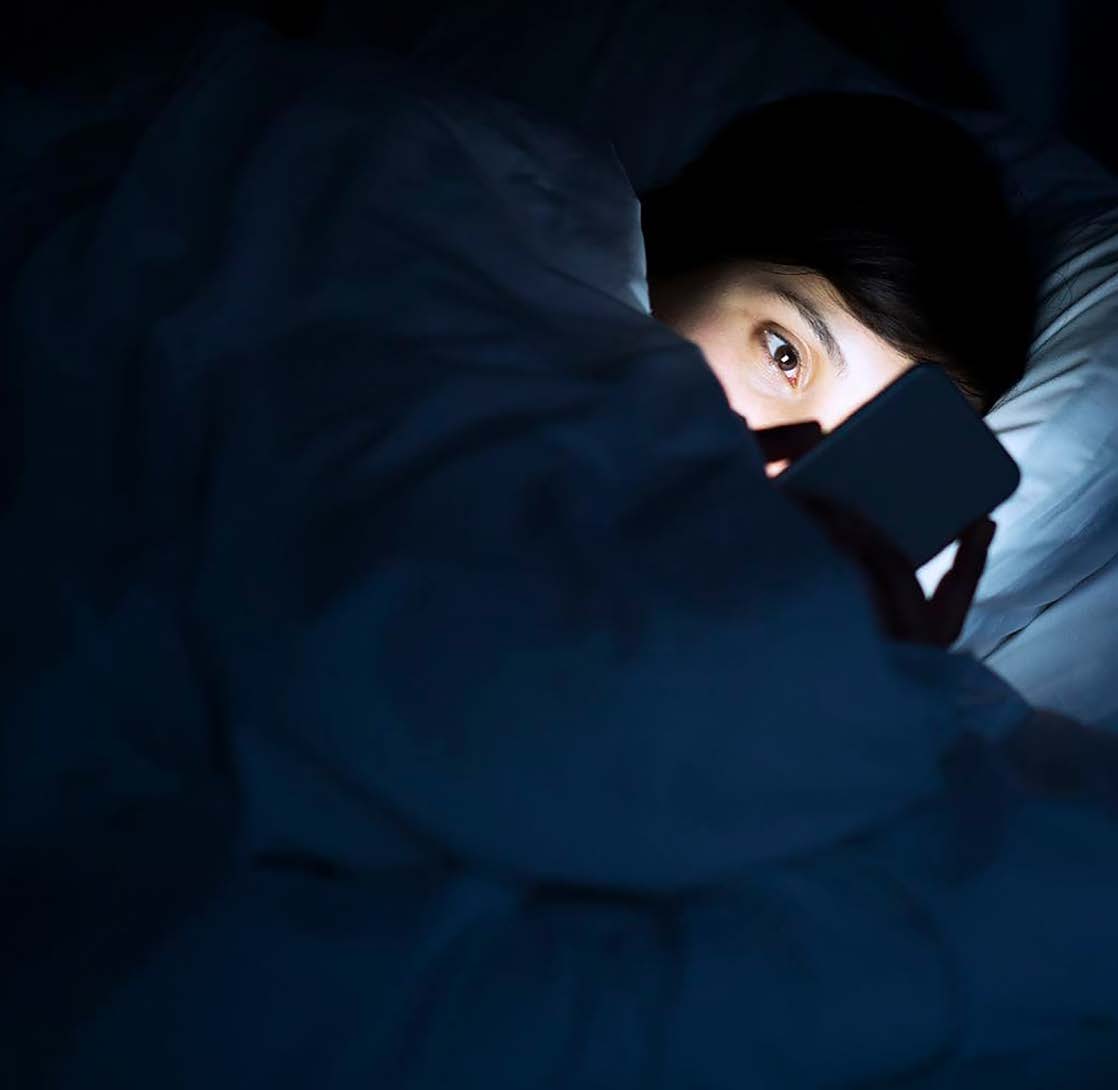
We as parents have to lead by example and show our kids healthy lifestyle habits by following our own advice. Turn your off WiFi at night, set your phone's display to night mode in the evening, minimize time in front of the television and get outside with your children.
BY DR. NATHALIE BEAUCHAMP B.SC., D.C., I.F.M.C.P.
Advancements in technology within recent years have come with many benefits. There is a world of information and entertainment conveniently located at our fingertips. The development of the smartphone alone has revolutionized the way we function, consolidating all of our needs into one small device. Even kids at school are now able to complete and submit their homework on tablets rather than carrying papers around. However, these technological advancements have also come at a cost for our health. From poor posture, nervous system functioning, attention, sleep, memory, and even learning, this article dives into the challenges caused by our uber-connected world. Here are four ways technology may be affecting you or your child's health:
four ways technology may be affecting you or your child's health
1. Anterior Head Syndrome aka "Text Neck"
Today, the widespread use of smartphones, blackberries, and tablets has caused an epidemic of what is now referred to as "text-neck'. The term is used to describe abnormal stressors on the neck (also called the cervical spine) from looking down at the screens of mobile devices. The cervical spine supports the weight of the head, which generally speaking weighs between ten to fourteen pounds — about the same as a large bowling ball.
When the spine is in its proper position, the weight of the head is carried directly above the center of gravity, preventing it from pulling on the rest of the spinal column. When the neck is too far forward, the bones of the spine can get misaligned, which in turn places excess stress on the nerve exiting from the spine, and as a result, impacts the nerve impulses being transmitted up and down the spine — think brain-body connection.
In recent years with the increased use of technology and the constant head forward posture held by so many, more and more people are experiencing symptoms like headaches, neck and shoulder pain, jaw pain and even problems with sustained concentration. Long term effects of anterior head syndrome can lead to the flattening of the proper cervical lordosis, disc degeneration, recurrent muscle strains and numbness and tingling down the arms. To make things worse, anterior head syndrome is being seen in younger and younger generations due to the popularity of technologies in education and for entertainment. Why is this a concern? Youth are in the midst of development and abnormal stresses on their spine can have a negative influence on the mechanics of youth's skeletal structure as they age. Loss of proper spinal structure and function can also weaken important sensory input into the central nervous system which can, in turn, affect their overall development and well-being.
The solution? Assuring proper setup and posture when using our device is a good start as well as limiting the use of our technologies as much as possible. However, sometimes it is not enough as the curvature loss and the abnormal spinal biomechanics have already begun and one may need the help of a chiropractor to address the issue. Chiropractors detect and correct misalignments of the spine to reinstate its normal balance and function which allows the nervous system to send and receive information without interference. This allows the body to maximize its self-healing properties and correct its natural posture.
2. Electromagnetic Field (EMF) Exposure
Between TVs, laptops, cell phones and Wi-Fi; being exposed to electromagnetic fields is almost inevitable in this day and age. Although under much debate, emerging evidence is showing more and more that prolonged exposure to these EMFs can wreak havoc on both our physical and mental health.
Conditions such as persistent headaches, difficulty with concentration, anxiety, depression, and other radiation-related issues have a higher risk of occurrence with EMF exposure, and symptoms can develop more severely in younger children. Children have smaller heads, thinner skulls and more fluid in the brain, allowing them to absorb more radiation than adults. EMF exposure has been linked to hyperactivity, sleep disturbances–due to effects on the pineal gland, which produces melatonin– memory and attention deficits, and increased stress levels in children. Some research has even shown an increase in learning disorders and behavioral problems when kids are exposed to EMFs even in the womb.
Adults are subject to more extensive side effects when cellular or wearable devices are carried near certain body parts. For men who keep their cellphones in their pockets, some research has shown a correlation between radiation and low sperm count, leading to fertility issues. For women, research has shown potential risk of ovarian problems when phones or portable devices are constantly kept in the pockets, or even increased chance of breast cancer when these devices are kept near the chest.
Now in a world where complete isolation from EMF sources is nearly impossible, there are certain precautions one can take. Turning off Wifi signals at night, having a "no technology zone" in the bedroom, having an EMF blocker on mobile devices, and keeping technology off the body as much as possible are all great ways to minimize exposure.
3. Blue Light Exposure
Until the advent of artificial lighting, the sun was the major source of lighting, and people spent their evenings in darkness; a very important factor in regulating sleep-wake cycles. Now, in much of the world, evenings are illuminated, but we may be paying a price for basking in all that light. At night, light (especially emitted from digital screens like TVs, computers, laptops, smartphones and tablets), electronic devices, and even fluorescent and LED lighting) throws the body's biological clock–the circadian rhythm–out of synch, causing our sleep and sleep quality to suffer. Even worse, research shows that this may contribute to the development of cancer, diabetes, heart disease, and obesity.
Now not all colors of light have the same effect. Blue wavelengths–which are beneficial during daylight hours because they boost attention, reaction times, and mood– seem to be the most disruptive at night. And the proliferation of electronics with screens, as well as energy-efficient lighting, is increasing our exposure to blue wavelengths, especially after sundown.
Moreover, prolonged exposure to these blue lights can greatly affect vision and even brain function. Digital eye strain is a new term used to describe the conditions resulting from the use of today's popular electronic gadgets and is considered a medical issue with serious symptoms that can affect learning and work productivity. Symptoms of digital eye strain, or computer vision syndrome, include blurry vision, difficulty focusing, dry and irritated eyes, headaches, and even trouble focusing. Digital eye strain does not just affect adults. Children are also at risk for eye strain due to their growing use of digital devices. Children today have more digital tools at their disposal than ever before–tablets, smartphones, e-readers, videogames are just among a few, and many parents report increased use of these devices in the evenings.
Although it would be ideal to power down in the evenings and avoid looking at our devices altogether, this isn't always an option. Many tools are now available to help avoid the adverse effects of prolonged blue light exposure such as blue light blocking glasses, orange or red screen covers, and even apps and programs that allow your electronic devices to emit a warmer colored light.
4. Lack of Movement
"Sitting is the new smoking" seems to be a catchphrase these days to describe the harmful effects of a chronic sedentary lifestyle. From long work hours seated at a desk to commuting to watching television, many adults aren't getting nearly as much exercise or daily movement they need to remain healthy. And worse, with the rise of technology, children are becoming more and more susceptible to this epidemic as well. The Centers for Disease Control (CDC) states that childhood obesity rates have tripled in 30 years and currently one out of every three kids are considered overweight. Moreover, lack of physical activity can interfere with both an adult and a child's ability to focus, learn, remember, process emotion and get good quality sleep.
Although many parents blame technology for their child's lack of exercise, 74 percent of parents to spend family time with their kids sitting in front of the TV and 53 percent spend extra time with their kids playing video games or using the computer. It's hard to strictly blame technology as a cause of kids' inactivity when often parents are also not active because of that same technology. In our world full of technologies, parents have to make a conscious effort to set time for physical activity and exercise as part of the family's daily or weekly routine.
Technology has revolutionized the way we live, however, we must not forget that using technology can pose a risk to our health and the health of our children. We as parents have to lead by example and show our kids healthy lifestyle habits by following our own advice. Turn your off WiFi at night, set your phone's display to night mode in the evening, minimize time in front of the television and get outside with your children. All of these things will help set a good example for the whole family.•
ABOUT THE AUTHOR:

Dr. Nathalie Beauchamp, B.Sc., D.C., IFMCP is an Ottawa-based Chiropractor, the owner of Santé Chiropractic and Wellness Centre, a Functional Medicine Practitioner, an international lecturer, and Radio/ TV personality. She is the author of the book Hack Your Health Habits: Simple, Action Driven, Natural Health Solutions for People On The Go! and the creator of the online coaching program Hack Your Health Habits Mastery Program. She is also the host of The What The Hack?! Podcast where she interviews other natural health practitioners to help people take control of their health. Dr. Nathalie's mission is to educate, lead and empower people to live their best lives!

- Title: Hack Your Health Habits: Simple, ActionDriven, Natural Health Solutions For People On The Go!
- Author: Dr, Nathalie Beauchamp
- Publisher: Wellness On The Go Press
- Publication Date: April 9 2019
- Paperback: 608 pages
- ISBN: 1775237230 ISBN-13: 978-1775237235
- Available at amazon.com and barnesandnoble.com